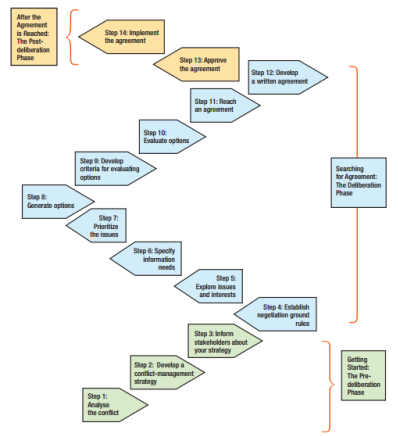Once all the parties have been informed, the first meeting convened and the protocols ratified, participants can begin to deliberate the substantive issues.
Step 4 – establish ground rules for the negotiation. The parties should adopt the ground rules and protocols drafted during the planning phase. Ground rules only work when all parties agree to abide by them. Rules can be added or modified as necessary, but all parties must approve any change before it is adopted.
Step 5 – explore the issues and interests. Parties educate each other: they describe their perceptions of the problem, identify and discuss the issues, explain their concerns and list their assumptions. This may be a time-consuming step but it is important because it allows each participant to describe their side of the story directly to the other parties. The aim should be to identify and share interests – the reasons, needs, concerns and motivations underlying particular positions – rather than to assert positions.
Step 6 – specify the information needs. In this step, parties:
- elicit more information about issues and interests;
- identify technical background information that is pertinent to the issues;
- identify information that is already available, and additional information that will be needed; and
- agree on methods for generating answers to technical questions, or, when there is no consensus on technical issues, agree on activities or processes such as field trips, data collection and reporting, briefings and interviews to obtain more information.
Step 7 – prioritize the issues. Parties collaboratively assign the issues as high priority, medium priority, low priority, and undecided. Issues that are likely to be easier to deal with should be put towards the top of the agenda. Deciding on a suitable entry point for talks is important because it can have an impact on the entire negotiation process. The entry point should be an issue that is important to all parties but not so complicated that it takes a long time to resolve.
Step 8 – generate options. Parties are encouraged to collaboratively create multiple options for resolving each issue, because the search for a good solution requires a broad discussion and “thinking outside the box”. Multiple options are also advisable because it is quite common for party X to suggest an option that party Y rejects. The goal at this stage is to produce the broadest possible range of alternatives.
Step 9 – develop criteria for evaluating options. In this step, parties collaboratively develop criteria for evaluating the merit of the various options. The use of objective criteria will facilitate the process of deciding the options that are most satisfactory to all parties, and it also ensures that there are fair and independent standards for decision-making.
Step 10 – evaluate the options. Parties apply the criteria developed in Step 9 to determine which options adequately meet their key interests.
All parties should be encouraged to look closely at their “best alternatives to a negotiated agreement” (BATNAs); in other words, each party needs to determine whether it is better off with or without the proposed agreement. BATNAs are influential factors in determining the outcome of a negotiation, because parties are often motivated to find common ground by their knowledge of what will happen if no agreement is reached. The no-agreement alternative is an important baseline from which all parties can evaluate the merits of the various options.
Step 11 – reach an agreement. There are several ways of coming up with an agreement:
- Standards and criteria – for example, find out which basic standards would be reasonable to all the parties. These should be reformulated as criteria on which to base future decisions.
- The status quo – consider which aspects of the relationship between parties are currently working, and include these in the agreement. Seek mutually acceptable and fair standards and criteria for framing the agreement.
- Agreements in principle – start with general principles on which all parties can agree, then clarify how these principles can be put in place to lead to an agreement.
- The building-block approach – break down the overall problem into several smaller problems, and put the solutions to each of these together to form a general agreement.
- Links and trades – to solve one problem, link it with another. If a local community wants compensation and jobs, a company could offer a set number of jobs as part of a compensation package.
- Procedural solutions to substantive problems – instead of a single solution, there may be a need to develop a process for tackling the issue over time.
- Vision building – this involves the parties imagining the future and working back from that vision.
- Model agreement – past successes from other areas are used to build or revise a suitable agreement for the current case.
- Single-text document – the mediator listens to all possible options and writes a draft. One by one, the parties add to or change the draft so that it works for them, until the document works for all parties.
Step 12 – develop a written agreement. Generally, an individual or a group of negotiators is assigned the task of preparing a draft agreement. If the agreement contains specialized information, such as complex legal or scientific language, the job of drafting may be assigned to a subgroup of negotiators who are familiar with the subject. All parties should review the document to determine whether it reflects the oral agreement they have already reached.



